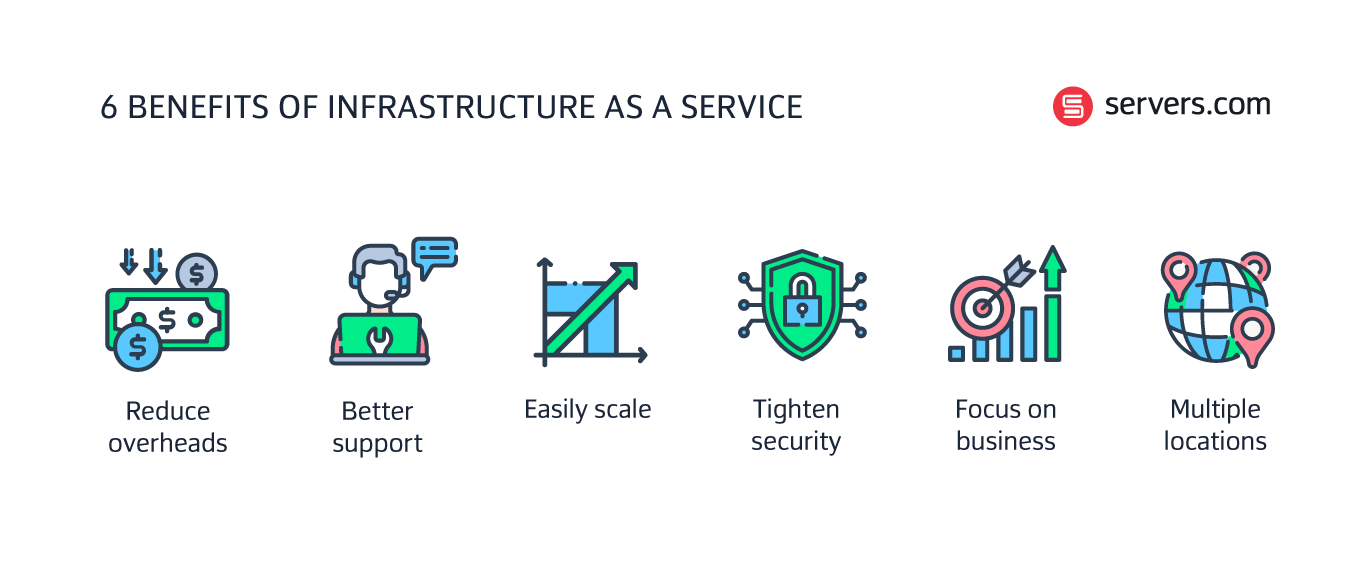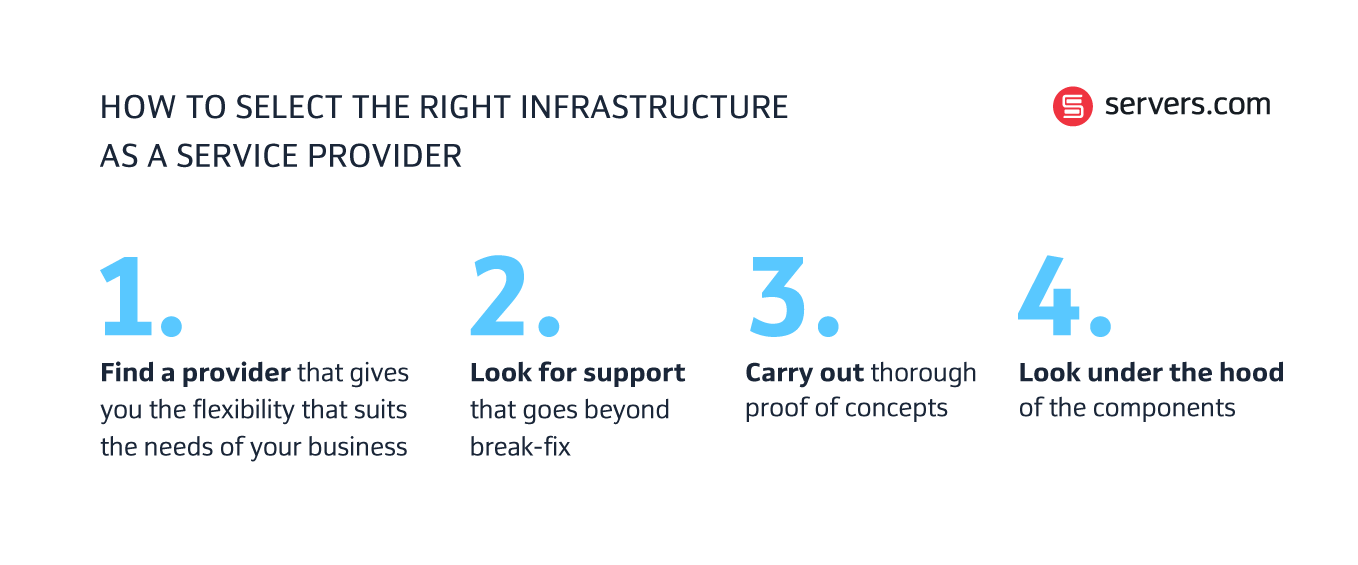![What is Infrastructure as a Service (IaaS)? | [A Simplified Go-to-Guide]](/dA/62bc9dbee1/image/Article.png)
![What is Infrastructure as a Service (IaaS)? | [A Simplified Go-to-Guide]](/dA/62bc9dbee1/image/Article.png)
Are you considering working with an infrastructure as a service provider? If so, you’ve come to the right place. This simplified go-to-guide will help you decide if infrastructure as a service is the right route for you, as well as better understand the advantages of infrastructure as a service and how to select the right provider to work with, covering:
What is infrastructure as a service?
How does infrastructure as a service work?
6 benefits of infrastructure as a service
How to select the right infrastructure as a service provider
A consistently expanding market, infrastructure as a service has grown from $51.3 billion in 2020 to a predicted $481.8 billion by 2030. Driven by demand for affordable, flexible infrastructure that enables businesses to grow profitably, infrastructure as a service today is used by companies of all sizes: from small entities that don’t have in-house IT teams, to large enterprises that want to focus their efforts on serving customers rather than managing infrastructure.
Infrastructure as a service or IaaS is a model for renting servers that are hosted in someone else’s data center and accessed via the cloud. These servers can either be physical bare metal machines or virtual machines.
The infrastructure as a service provider hosts the physical IT infrastructure in data centers and delivers the IT infrastructure - including: hardware, compute, storage and network – as a service that customers pay for on an hourly, daily, monthly, yearly or multi-year basis.
The provider will also manage the ongoing maintenance and monitoring of the infrastructure. Additional services on top are available if you opt for a managed IaaS package.
Unmanaged – the hosting provider sets up the server environment. The customer is then responsible for deploying and managing the applications on that infrastructure. An unmanaged hosting provider will hand over root level access to the customer.
Managed - the hosting provider sets up the server environment and also deploys and manages the applications on that infrastructure. A managed hosting provider will maintain root level access.
At its core, infrastructure as a service works by having remote access to servers that aren’t under your ownership but are under your control.
When it comes to hosting infrastructure, there are four vital elements:
Space – to house the infrastructure. Otherwise known as a data center.
Power – delivered via substantial connectivity to the national or local grid.
Internet – delivered via connectivity to multiple internet service providers (ISPs) including local ISPs and Tier 1 and 2 long-distance ISPs.
Servers – including all the hardware involved in powering them.
Unlike co-location hosting where only the first two elements are provided, infrastructure as a service hosting includes all four. Infrastructure as a service providers house the servers in their data center(s), which are usually situated in various locations around the world, connect that data center to power, and set up and manage the relationships with ISPs.
Included within an infrastructure as a service providers’ remit is:
Providing computing power and space
Keeping data center infrastructure up to date
Protecting the data center against external influences
Delivering server and network structures
Offering an environment, e.g. a customer portal, through which customers can access their server resources and the provider’s services
The costs of running the data center environment are shared by all users of that data center. That includes the cost of building out routing equipment to multiple ISPs, managing the relationships with ISPs, powering the data center as well as the team that monitor and manage the physical hardware 24/7. Infrastructure as a service providers will also be able to get better deals on the hardware itself as they buy it in bulk vs one company buying a handful of servers at a time.
To monitor infrastructure 24/7 requires a team of at least 7-8 people to cover shifts and absence. That’s a big operational overhead. By working with an IaaS provider, that cost is shared. Companies also get access to a 24/7 support team that does the job well because they are doing it at scale.

Infrastructure as a service providers can provision and deploy servers within minutes. With most offering month to month contracts, you can scale the number of servers you’re using up or down, reducing the need to over or under-provision infrastructure. This amount of flexibility means companies can do infrastructure as a service as cheaply as if they were hosting the infrastructure themselves on long-term depreciating assets.
This is perhaps the most undervalued benefit behind infrastructure as a service. It gives companies the ability to focus on the work that drives revenue rather than on their infrastructure.
Consider this: If you needed an email system for your company, would you write your own email package? Probably not. You’d likely pay for Microsoft Outlook or Gmail because they have been designed by specialists in that area for that specific job. The same can be said of infrastructure as a service. Let the infrastructure experts do what they’re best at so you can do what you’re best at.
IaaS companies have dedicated security teams dealing with the latest in government changes across data center locations and working on security and compliance requirements at an industry level. It allows them to help ensure customer’s infrastructure complies with local laws. Access to that expertise at a shared cost is one of the biggest benefits of infrastructure as a service.
For companies that need infrastructure in multiple locations around the world, working with an infrastructure as a service provider is the simplest and most cost-effective hosting option. Companies can quickly rent servers in the location that they need and scale up or down depending on the success of that location.
The success of and demand for infrastructure as a service means that the market is flooded with different providers. Selecting the one that is best for your business can be challenging. We believe that there are certain must-haves that help identify the best IaaS companies.
Find a provider that gives you the flexibility that suits the needs of your business. For example, you know from your current set up that you have very predictable and stable requirements of your infrastructure. In which case, a long-term contract with an infrastructure as a service provider might be a better option to help save some money.
On the flipside, you are a company that is growing and the technology you are using is regularly changing. An IaaS partner that offers more flexibility with month-to-month contracts would be a better option in this instance.
The key is to work out what level of flexibility you need for your scaling requirements, both up and down.
Technology goes wrong. That’s a fact. Today’s systems are complex and reliant on so many different elements working together that sometimes failures and outages occur.
Which is why the support that an infrastructure as a service company provides is absolutely crucial. Many rely on ticket systems that can take days to reply to a customer query. Not very helpful when the matter is urgent.
When things go wrong, people want communication and to feel heard – to know that their issue is being resolved and that they are being kept informed on progress. So, look for a provider that offers IaaS users access to support that is 24/7, with the option to interact with a human rather than a faceless system or bot.
The best IaaS providers will also allocate each customer an account team which is available to support when issues occur. They are also there to provide ongoing guidance on optimizing infrastructure and ensuring the server set up supports the wider goals of the business.

As our CRO Isaac Douglas said in his LinkedIn article on the topic – “proof of concepts (POCs) are…an absolutely crucial part of buying infrastructure”.
But there are various ways to approach POCs and the best one is to go beyond just the technical and experience what it’s like to do business with a provider.
From a technical perspective, be clear on what your specific metrics are for success. For example, have a specific performance target in mind for the network rather than just testing the networking performance in general.
From a business perspective, look at what the invoice process is like. Does my accounting team like the format of the invoice? Is the invoice correct? How often will I receive an invoice? And what are the communications like with and from the provider. For example, have I been assigned an account manager and how long does it take them to respond to a query? Will the team guiding me through the initial purchase be the team that will be managing my account moving forward?
Lastly, test the support. Break something on purpose, put in a ticket or message the support line and see if their response aligns with their SLAs. Test the customer portal experience and what it’s like to buy something else. If I want to cancel something, what is the process? Can I get access to senior decision makers at the company?
Not all components are made equal and it’s important to know what each IaaS company is providing. Take SSDs for example. There are cheap SSDs and expensive SSDs. As expected, the performance of cheap SSDs is significantly poorer than the more costly option.
Similarly, from a networking perspective, you will often see servers offered with port speeds of 10Gbit/s or more, which in theory should allow each server in that rack to use almost 100% of that available port speed at the same time.
What is often overlooked is the connection capacity between the top of rack switch and the distribution switch, and in most instances, this is the limiting factor when it comes to throughput.
Looking under the hood of the components on offer a little more will likely save you from disappointment down the line.
We are a global infrastructure as a service hosting platform, bridging the gap between traditional bare metal hosting and hyperscale cloud providers to deliver a service that offers scalability and flexibility with month-to-month contracts.
Our pre-racked, pre-stacked server configurations, customizable RAM, disk and networking elements are delivered quickly and cost effectively in ISO 27001, ISO 9001 data centers in the US, EU countries, UK, Singapore, and Hong Kong.
When someone becomes a customer of servers.com, the team that onboards them stays with them as their dedicated account team. And on average our customers receive a response to tickets from our 24/7 support team in less than 15 minutes.
To learn more about how we work with companies to deliver infrastructure as a service to businesses of all sizes, check out our customer stories.